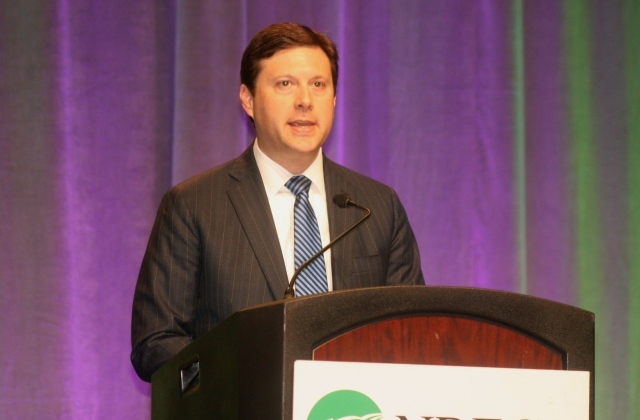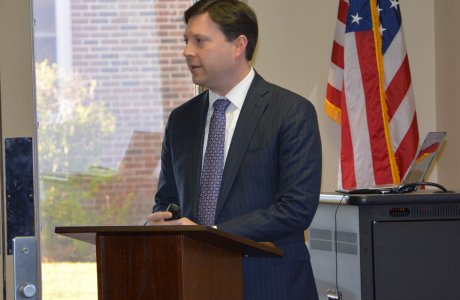
Brandon McBride has been administrator of the Rural Utilities Service since 2015. McBride was a senior professional staffer in Congress on rural issues before President Obama appointed him to head RUS. In this Q&A, he answers questions about the role that RUS and rural electric cooperatives can play in meeting the needs of rural America.
Q. What is the biggest challenge you have faced since becoming administrator of RUS?
A. One of the biggest challenges is to keep reminding the public, policy makers and even rural electric cooperatives what a big job they have and how hard it is to serve rural, remote and sparsely populated areas. The success of our program and its partnership with rural electric cooperatives has made too easy to underestimate both the difficulty and importance of providing affordable power to the 80 percent of America’s geography that is rural.
Q. What do you see as the major recent accomplishments of RUS in connection with electric co-ops?
A. I am very proud that RUS continues to be a reliable, affordable and flexible source of capital for rural electric infrastructure investment. We succeeded in implementing the new Rural Energy Savings Plan, which will make $52 million in zero-interest loans available to energy providers to help rural families and small businesses reduce energy use. This new program, called RESP, is already oversubscribed. RESP builds on our work to increase funding for energy efficiency under the Energy Efficiency and Conservation Loan Program.
I am also very pleased that Rural Development published an environmental regulation which considered and carefully balanced the comments of hundreds of Americans concerned with both a cleaner, greener future and affordable power for rural America. The reviews have been good and I believe we got the balance right, thanks to input from NRECA, rural electric cooperatives and commenters on all sides of this issue. Publishing a final rule in this area removed uncertainty and opens the door to investments for the future.
It’s also very exciting to see the rural electric cooperative movement continue to grow and provide 21st century leadership for affordable power. For example, I am pleased that RUS helped electric distribution cooperatives serving southern Minnesota acquire a portion of an investor-owned utility’s territory and assets which will improve service, efficiency and reliability for customers and improve the economics of the service territory. The July 2015 acquisition was a win/win for everyone.
Q. What do you say to critics who argue RUS has accomplished its mission of electrifying rural America and is no longer needed?
A. Distance and density remain the largest barriers to modern utility service for rural Americans. Affordable power, as well as affordable telecommunications, water and sewer services are all critical to the rural quality of life and rural economic development. As long as rural communities need to improve and upgrade electric systems, gain access to affordable, robust broadband service, and invest in clean, safe water, RUS programs will continue to be relevant.
Networks need continuous care, modernization and maintenance to survive and thrive. We are also seeing dramatic technology, market and regulatory changes affect the entire electric market. RUS financing is critical for rural utilities to manage their costs in a changing environment. In capital intensive industries, like electric service, low cost capital translates into lower power rates for residential and business consumers.
As long as the cooperative business model continues to succeed at providing affordable, reliable electric power to rural communities, RUS and its sister Rural Development programs can help with funding for a variety of community facilities, housing and business needs.
Q. What are the strengths of RUS as a financing source versus private lenders and how do you ensure co-ops have flexibility to meet their local needs?
A. One of the greatest strengths of the RUS program is that it facilitates the participation of private lenders. I believe that the rural electric system is well served by a diversified portfolio of borrowing. The power of the RUS/REA system is that it is based on years of practical utilities experience and builds borrower equity and creditworthiness as borrowers finance and build their electric systems. As the electric industry evolves with new technologies and renewable energy, investment will be critical not just for rural economies, but nationwide. There is an advantage in portfolio diversity, with a mix of private funds and RUS’ extremely low interest rates.
Working with borrowers, co-lenders and applicants, RUS is dedicated to finding financing solutions for rural electric cooperatives which meet the modern needs of rural America.
Q. Co-ops and RUS have key partnerships on programs like REDLG and the Rural Energy Savings program. Where do you see these programs going?
A. Across America, rural electric cooperatives are leading rural economic development; improving the quality of life and investing in the future. The REDLG program, where co-ops borrow funds to relend for rural economic development, and the Rural Energy Savings Program and the Energy Efficiency Conservation Loan Program where co-ops borrow funds for energy efficiency, help rural electric co-ops meet the needs of their communities. For example, Quinter, Kansas with a population of 1,000, was able to build a new fire station to better meet the needs of the 400-square mile service area, with funding from a REDLG loan from Midwest Energy.
These programs can help rural electric cooperatives better meet the needs of their customers and their communities. Whether a co-op wants to help customers reduce power use and costs, or improve access to health care by funding a medical clinic, REDLG and RESP offer solutions that can improve the quality of life in rural communities. These are just two examples of our partnership that works in so many ways to make rural America the great place that it is.
Q. How can RUS and co-ops work together to expand access to high-speed Internet in unserved rural areas?

A. Today, 40 percent of those who live and work in rural areas lack the same access to affordable high-speed internet service common in non-rural areas. The Obama Administration is very much focused on ways to improve access to broadband service.
RUS and the Commerce Department’s National Telecommunications Information Administration are leaders in the Broadband Opportunity Council’s effort to expand broadband access. We clearly need more partnerships in rural areas to leverage all available resources to support broadband deployment. Rural electric cooperatives are in a unique position to help achieve that goal. With changes in the electric utility industry and in rural America, broadband is a critical element in the ability of rural electric cooperatives to respond to new customer needs. And RUS, with experience in both electric and telecommunications systems, is ready to assist them by offering low cost financing to deploy infrastructure for high-speed internet access, including smart grid technologies, through our telecommunications, broadband and electric programs.
I also want to recognize Jo Ann Emerson for bringing her passion for rural broadband to NRECA. That is a lasting legacy. As a result of her work, rural electric and telecomm providers have launched a productive dialogue on ways to connect rural America to the world of high speed internet access. This is critical to rural America’s efforts to reach its full potential.